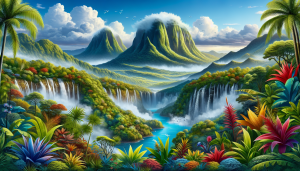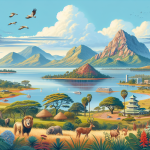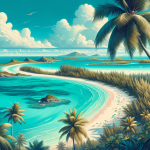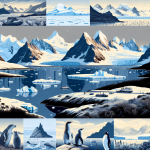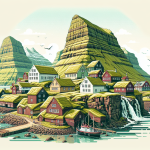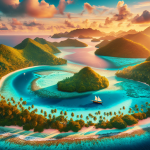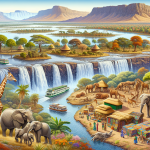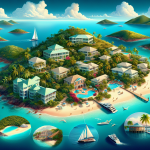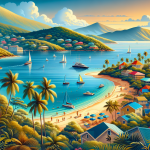Discovering the Hidden Gem of the Caribbean: Dominica
Dominica, often referred to as “The Nature Island,” is a verdant paradise tucked away in the Lesser Antilles region of the Caribbean. Unlike its more commercialized neighbors, Dominica remains largely untouched, offering travelers a unique blend of unspoiled landscapes, vibrant culture, and adventurous activities. With lush rainforests, towering waterfalls, and the second-largest hot spring in the world, this island beckons nature enthusiasts, thrill-seekers, and those looking to escape the hustle and bustle of modern life. In this comprehensive guide, we will explore everything you need to know about Dominica, from its stunning natural attractions and rich cultural heritage to practical travel tips and the best times to visit. Whether you’re planning a relaxed getaway or an action-packed adventure, Dominica promises an experience unlike any other. So, pack your bags and get ready to discover why this island is considered one of the Caribbean’s best-kept secrets.
Dominica’s Natural Wonders
The Boiling Lake
One of the most fascinating natural attractions in Dominica is the Boiling Lake. Located within the Morne Trois Pitons National Park, this lake is the second-largest hot spring in the world. The hike to the Boiling Lake is not for the faint of heart; it’s a challenging trek that takes approximately six hours round trip. However, the journey is well worth it, as hikers are rewarded with stunning views of the island’s interior, including lush rainforests, deep valleys, and volcanic landscapes. The lake itself is a sight to behold, with its bubbling waters reaching temperatures of up to 197°F (92°C).
Trafalgar Falls
Another must-see natural wonder in Dominica is Trafalgar Falls, often referred to as the “Mother and Father” falls. These twin waterfalls are located near the village of Trafalgar and are easily accessible via a short hike. The larger of the two falls, known as the “Father,” cascades from a height of 125 feet, while the smaller “Mother” falls drops from 75 feet. Visitors can take a refreshing dip in the crystal-clear pools at the base of the falls or simply enjoy the stunning scenery.
Emerald Pool
Nestled within the Morne Trois Pitons National Park, the Emerald Pool is another popular attraction in Dominica. This enchanting pool is fed by a small waterfall and is surrounded by lush vegetation, making it a perfect spot for a refreshing swim. The pool gets its name from the vibrant green color of the water, which is caused by the surrounding foliage reflecting in the sunlight. The hike to the Emerald Pool is relatively easy and takes about 30 minutes, making it an accessible destination for visitors of all fitness levels.
Cultural Heritage of Dominica
Kalinago Territory
Dominica is home to the Kalinago people, one of the last remaining indigenous communities in the Caribbean. The Kalinago Territory, located on the island’s east coast, offers visitors a unique opportunity to learn about the history, culture, and traditions of the Kalinago people. Visitors can explore traditional thatched huts, watch demonstrations of traditional crafts such as basket weaving and canoe building, and enjoy performances of traditional music and dance. The Kalinago Barana Aute, a cultural village within the territory, provides an immersive experience that offers a glimpse into the daily lives of the Kalinago people.
Roseau
The capital city of Roseau is a vibrant blend of old and new, with charming colonial architecture, bustling markets, and a lively waterfront. Visitors can explore the historic Old Market Plaza, which dates back to the 18th century and offers a variety of local goods, including fresh produce, spices, and handmade crafts. The Dominica Museum, located in the heart of Roseau, provides a comprehensive overview of the island’s history, culture, and natural environment. For those looking to immerse themselves in local culture, the Roseau Market is a must-visit, offering a wide array of local foods, crafts, and souvenirs.
Adventure Activities in Dominica
Scuba Diving and Snorkeling
Dominica is renowned for its pristine marine environment and offers some of the best scuba diving and snorkeling in the Caribbean. The island’s underwater world is teeming with vibrant coral reefs, diverse marine life, and fascinating underwater formations. Popular dive sites include Champagne Reef, where underwater volcanic vents create a unique “champagne” effect, and Scott’s Head Pinnacle, known for its dramatic drop-offs and abundant marine life. Snorkelers can explore the shallow reefs at Soufriere Bay and the marine reserve at Cabrits National Park, where they can encounter colorful fish, sea turtles, and even dolphins.
Hiking and Trekking
With its rugged terrain and dense rainforests, Dominica is a hiker’s paradise. The island boasts an extensive network of trails that cater to all skill levels, from leisurely walks to challenging treks. One of the most popular hikes is the Waitukubuli National Trail, the Caribbean’s longest hiking trail, which spans 115 miles (185 kilometers) and traverses the entire island. The trail is divided into 14 segments, each offering a unique experience, from coastal walks and river crossings to mountain climbs and village visits. Other popular hikes include the Boiling Lake trail, the Middleham Falls trail, and the Syndicate Nature Trail.
Whale Watching
Dominica is one of the best places in the Caribbean to go whale watching, with a resident population of sperm whales and frequent sightings of humpback, pilot, and orca whales. Whale watching tours operate year-round, with the best time to see these magnificent creatures being between November and March. Tours typically depart from Roseau and Soufriere, and experienced guides provide informative commentary on the whales’ behavior and biology. In addition to whales, visitors may also spot dolphins, sea turtles, and various seabirds during their tour.
Practical Travel Tips for Dominica
Best Time to Visit
The best time to visit Dominica is during the dry season, which runs from December to April. During this time, the weather is warm and sunny, with lower humidity and minimal rainfall. This is also the peak tourist season, so it’s advisable to book accommodations and activities in advance. The wet season, which runs from June to November, brings higher humidity and frequent rain showers, but it is also a great time to experience the island’s lush vegetation and vibrant waterfalls. Keep in mind that Dominica is located in the hurricane belt, so it’s important to stay informed about weather conditions if traveling during the hurricane season.
Getting There and Around
Dominica is served by two airports: Douglas-Charles Airport (DOM) and Canefield Airport (DCF). Douglas-Charles Airport, located on the northeast coast, is the main international gateway and receives flights from several Caribbean islands, including Antigua, Barbados, and St. Lucia. Canefield Airport, located near Roseau, primarily serves domestic and regional flights. There are no direct flights from the United States or Europe, so travelers will need to connect through a neighboring island.
Once on the island, visitors can get around by rental car, taxi, or public transportation. Renting a car is a convenient option for exploring the island at your own pace, but be prepared for narrow, winding roads and driving on the left side. Taxis are readily available and can be hired for short trips or full-day tours. Public buses, known as “minibuses,” operate on fixed routes and are an affordable way to travel between towns and villages.
Accommodations
Dominica offers a range of accommodations to suit all budgets and preferences, from luxury resorts and boutique hotels to guesthouses and eco-lodges. Many of the island’s accommodations are located in or near nature reserves, offering easy access to hiking trails, waterfalls, and other natural attractions. Popular areas to stay include Roseau, Portsmouth, and the Kalinago Territory. For a unique experience, consider staying in an eco-lodge or treehouse, which allows you to immerse yourself in the island’s natural beauty while minimizing your environmental impact.
Conclusion
Dominica is a destination that captivates the senses and nourishes the soul. Its unspoiled landscapes, rich cultural heritage, and abundance of outdoor activities make it a haven for nature lovers and adventurers alike. Whether you’re exploring the rugged trails of the Waitukubuli National Trail, diving into the crystal-clear waters of Champagne Reef, or immersing yourself in the vibrant culture of the Kalinago people, Dominica offers an experience that is both authentic and unforgettable. So, if you’re looking for a Caribbean destination that offers more than just sun and sand, pack your bags and set your sights on Dominica – the Nature Island awaits.
For more information and travel planning, you can visit the official tourism website of Dominica.
